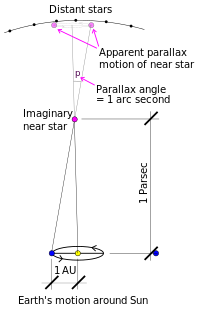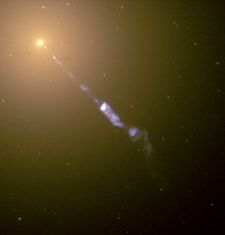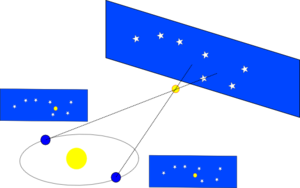فرسخ
| فرسخ | |
|---|---|
 A parsec is the distance from the Sun to an astronomical object that has a parallax angle of one arcsecond (not to scale) | |
| معلومات عامة | |
| نظام الوحدات | astronomical units |
| وحدة قياس | length/distance |
| الرمز | pc |
| التحويلات | |
| 1 pc في ... | ... يساوي ... |
| metric (SI) units | 3.0857×1016 m ~31 petametres |
| imperial & US units | 1.9174×1013 mi |
| astronomical units | 2.06265×105 au 3.26156 ly |
الفرسخ الفلكي Parsec هي وحدة قياس يستعملها الفلكيون لقياس المسافات الكبيرة بين الكواكب، وهي تساوي 326 سنة ضوئية.
The parsec unit was probably first suggested in 1913 by the British astronomer Herbert Hall Turner.[1] Named as a portmanteau of the parallax of one arcsecond, it was defined to make calculations of astronomical distances from only their raw observational data quick and easy for astronomers. Partly for this reason, it is the unit preferred in astronomy and astrophysics, though the light-year remains prominent in popular science texts and common usage. Although parsecs are used for the shorter distances within the Milky Way, multiples of parsecs are required for the larger scales in the universe, including kiloparsecs (kpc) for the more distant objects within and around the Milky Way, megaparsecs (Mpc) for mid-distance galaxies, and gigaparsecs (Gpc) for many quasars and the most distant galaxies.
In August 2015, the IAU passed Resolution B2, which, as part of the definition of a standardized absolute and apparent bolometric magnitude scale, mentioned an existing explicit definition of the parsec as exactly 648000/π astronomical units, or approximately 3.08567758149137×1016 metres (based on the IAU 2012 exact SI definition of the astronomical unit). This corresponds to the small-angle definition of the parsec found in many contemporary astronomical references.[2]
التاريخ والاشتقاق
The parsec is defined as being equal to the length of the longer leg of an extremely elongated imaginary right triangle in space. The two dimensions on which this triangle is based are its shorter leg, of length one astronomical unit (the average Earth-Sun distance), and the subtended angle of the vertex opposite that leg, measuring one arc second. Applying the rules of trigonometry to these two values, the unit length of the other leg of the triangle (the parsec) can be derived.
حساب قيمة الفرسخ
In the diagram above (not to scale), S represents the Sun, and E the Earth at one point in its orbit. Thus the distance ES is one astronomical unit (au). The angle SDE is one arcsecond (1/3600 of a degree) so by definition D is a point in space at a distance of one parsec from the Sun. Through trigonometry, the distance SD is calculated as follows:
Because the astronomical unit is defined to be 149597870700 m,[3] the following can be calculated:
| Therefore, 1 parsec | ≈ 206264.806247096 astronomical units |
| ≈ 3.085677581×1016 metres | |
| ≈ 19.173511577 trillion miles | |
| ≈ 3.261563777 light-years |
A corollary states that a parsec is also the distance from which a disc one astronomical unit in diameter must be viewed for it to have an angular diameter of one arcsecond (by placing the observer at D and a diameter of the disc on ES).
Mathematically, to calculate distance, given obtained angular measurements from instruments in arcseconds, the formula would be:
where θ is the measured angle in arcseconds, Distanceearth-sun is a constant (1 AU or 1.5813×10−5 ly). The calculated stellar distance will be in the same measurement unit as used in Distanceearth-sun (e.g. if Distanceearth-sun = 1 AU, unit for Distancestar is in astronomical units; if Distanceearth-sun = 1.5813×10−5 ly, unit for Distancestar is in light years).
The length of the parsec used in IAU 2015 Resolution B2[4] (exactly 648000/π astronomical units) corresponds exactly to that derived using the small-angle calculation. This differs from the classic inverse-tangent definition by about 200 km, i.e. only after the 11th significant figure. As the astronomical unit was defined by the IAU (2012) as an exact SI length in metres, so now the parsec corresponds to an exact SI length in metres. To the nearest meter, the small-angle parsec corresponds to 30,856,775,814,913,673 m.

Parsecs and kiloparsecs
Distances expressed in parsecs (pc) include distances between nearby stars, such as those in the same spiral arm or globular cluster. A distance of 1000 parsecs (3262 light-years) is commonly denoted by the kiloparsec (kpc). Astronomers typically use kiloparsecs to express distances between parts of a galaxy, or within groups of galaxies. So, for example:
- One parsec is approximately 3.26 light-years.
- Proxima Centauri, the nearest known star to earth other than the sun, is about 1.30 parsecs (4.24 light-years) away, by direct parallax measurement.
- The distance to the open cluster Pleiades is 130±10 pc (420±30 ly) from us, per Hipparcos parallax measurement.
- The centre of the Milky Way is more than 8 kiloparsecs (26000 ly) from the Earth, and the Milky Way is roughly 34 kpc (110000 ly) across.
- The Andromeda Galaxy (M31) is about 780 kpc (2.5 million light-years) away from the Earth.
Megaparsecs and gigaparsecs
A distance of one million parsecs is commonly denoted by the megaparsec (Mpc). Astronomers typically express the distances between neighbouring galaxies and galaxy clusters in megaparsecs.
وحدات حجم
To determine the number of stars in the Milky Way, volumes in cubic kiloparsecs[أ] (kpc3) are selected in various directions. All the stars in these volumes are counted and the total number of stars statistically determined. The number of globular clusters, dust clouds, and interstellar gas is determined in a similar fashion. To determine the number of galaxies in superclusters, volumes in cubic megaparsecs[أ] (Mpc3) are selected. All the galaxies in these volumes are classified and tallied. The total number of galaxies can then be determined statistically. The huge Boötes void is measured in cubic megaparsecs.[5]
انظر أيضاً
ملاحظات
المراجع
- ^ Dyson, F. W. (March 1913). "Stars, Distribution and drift of, The distribution in space of the stars in Carrington's Circumpolar Catalogue". Monthly Notices of the Royal Astronomical Society. 73 (5): 334–342. Bibcode:1913MNRAS..73..334D. doi:10.1093/mnras/73.5.334.
There is a need for a name for this unit of distance. Mr. Charlier has suggested Siriometer ... Professor Turner suggests parsec, which may be taken as an abbreviated form of 'a distance corresponding to a parallax of one second'.
- ^
- Cox, Arthur N., ed. (2000). Allen's Astrophysical Quantities (4th ed.). New York: AIP Press / Springer. Bibcode:2000asqu.book.....C. ISBN 978-0387987460.
- Binney, James; Tremaine, Scott (2008). Galactic Dynamics (2nd ed.). Princeton, NJ: Princeton University Press. Bibcode:2008gady.book.....B. ISBN 978-0-691-13026-2.
- ^ International Astronomical Union, ed. (31 August 2012), "RESOLUTION B2 on the re-definition of the astronomical unit of length", RESOLUTION B2, Beijing: International Astronomical Union, "The XXVIII General Assembly of International Astronomical Union recommends [adopted] that the astronomical unit be redefined to be a conventional unit of length equal to exactly 149597870700 m, in agreement with the value adopted in IAU 2009 Resolution B2"
- ^ "Four Resolutions to be Presented for Voting at the IAU XXIX GA".
- ^ Kirshner, R. P.; Oemler, A., Jr.; Schechter, P. L.; Shectman, S. A. (1981). "A million cubic megaparsec void in Bootes". The Astrophysical Journal. 248: L57. Bibcode:1981ApJ...248L..57K. doi:10.1086/183623. ISSN 0004-637X.
{{cite journal}}: CS1 maint: multiple names: authors list (link)
وصلات خارجية
- Guidry, Michael. "Astronomical Distance Scales". Astronomy 162: Stars, Galaxies, and Cosmology. University of Tennessee, Knoxville. Archived from the original on 12 December 2012. Retrieved 26 March 2010.
{{cite web}}: Unknown parameter|dead-url=ignored (|url-status=suggested) (help) - Merrifield, Michael. "pc Parsec". Sixty Symbols. Brady Haran for the University of Nottingham.

